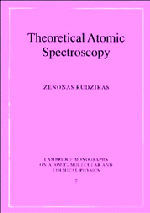Book contents
- Frontmatter
- Contents
- Preface
- Foreword to the Paperback Edition
- Introduction
- Part 1 Energy Spectrum of Many-electron Atom. Radiative and Autoionizing Transitions (Initial Formulas)
- Part 2 Foundations of the Angular Momentum Theory. Graphical Methods
- Part 3 Description of Complex Electronic Configurations
- Part 4 Second-quantization in the Theory of an Atom. Quasispin and Isospin
- 13 Second-quantization and irreducible tensorial sets
- 14 Operators and matrix elements in second-quantization representation
- 15 Quasispin for a shell of equivalent electrons
- 16 Algebraic expressions for coefficients of fractional parentage (CFP)
- 17 Tensorial properties and quasispin of complex configurations
- 18 Isospin in the theory of an atom
- Part 5 Matrix Elements of the Energy Operator
- Part 6 Electric and Magnetic Multipole Transitions
- Part 7 Calculation of Energy Spectra and Electronic Transitions in the Case of Complex Configurations
- Epilogue
- References
- Index
13 - Second-quantization and irreducible tensorial sets
Published online by Cambridge University Press: 21 September 2009
- Frontmatter
- Contents
- Preface
- Foreword to the Paperback Edition
- Introduction
- Part 1 Energy Spectrum of Many-electron Atom. Radiative and Autoionizing Transitions (Initial Formulas)
- Part 2 Foundations of the Angular Momentum Theory. Graphical Methods
- Part 3 Description of Complex Electronic Configurations
- Part 4 Second-quantization in the Theory of an Atom. Quasispin and Isospin
- 13 Second-quantization and irreducible tensorial sets
- 14 Operators and matrix elements in second-quantization representation
- 15 Quasispin for a shell of equivalent electrons
- 16 Algebraic expressions for coefficients of fractional parentage (CFP)
- 17 Tensorial properties and quasispin of complex configurations
- 18 Isospin in the theory of an atom
- Part 5 Matrix Elements of the Energy Operator
- Part 6 Electric and Magnetic Multipole Transitions
- Part 7 Calculation of Energy Spectra and Electronic Transitions in the Case of Complex Configurations
- Epilogue
- References
- Index
Summary
General remarks
As already mentioned in the Introduction, the exact solution of the main equation of quantum mechanics – the Schrödinger equation – lies beyond the potentialities of modern mathematics and computer technology. But a number of important inferences about the behaviour, structure and properties of a given quantum-mechanical many-particle system can be drawn without solving this equation, just by examining its symmetry properties.
Symmetry concepts come about in physics in two ways. First, since any physical process occurs in a real space, we have to make use of one or another coordinate system. The isotropy and homogeneity of space make physically meaningful only those mathematical relationships that remain unchanged under rotations of the axes of the coordinate system, and that impose fairly rigorous constraints on the possible physical laws. Second, every physical object and process features a symmetry which should be taken into account by the physical theory.
A common idea underlying particular forms of symmetry is the invariance of a system under a certain set (group) of transformations. The normally considered forms of symmetry are rotational symmetry, which is based on the equivalence of all directions in space, and permutation symmetry, which is caused by identical particles. The operations of the geometrical symmetry group are responsible for appropriate conservation laws. So, the rotational symmetry of a closed system gives rise to the law of conservation of angular momentum.
The group of rotations of a three-dimensional space stands apart in atomic spectroscopy. This is mostly due to the high accuracy of the central field approximation, on which the entire modern theory of complex atoms and ions is based.
- Type
- Chapter
- Information
- Theoretical Atomic Spectroscopy , pp. 109 - 120Publisher: Cambridge University PressPrint publication year: 1997



